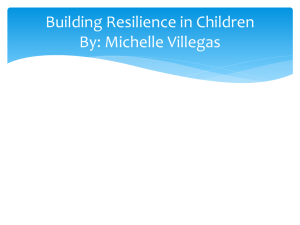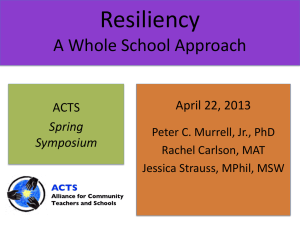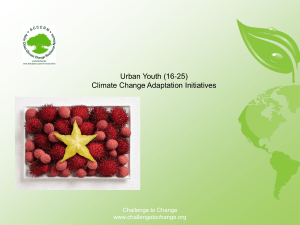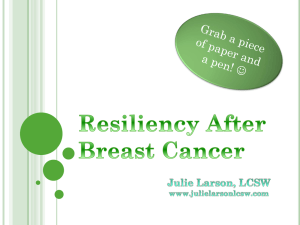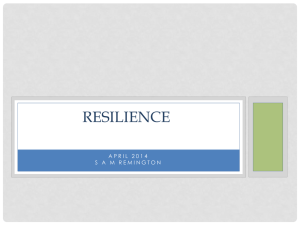Kelali_Genesis of Climate Resilient Highland Transformation
advertisement
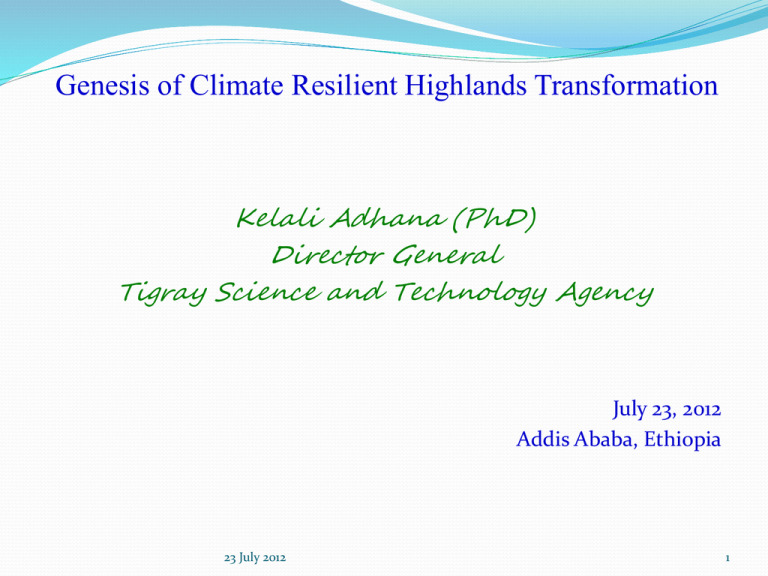
Genesis of Climate Resilient Highlands Transformation Kelali Adhana (PhD) Director General Tigray Science and Technology Agency July 23, 2012 Addis Ababa, Ethiopia 23 July 2012 1 Presentation Outline 1. Introduction 2. 3. 4. 5. Policy option on climate change Climate Resilience Economics of Climate Change Resiliency (definition) 6. Environment Environment resiliency and Society Biodiversity and Resiliency Resiliency in knowledge Climate Resilient Highland Transformation 7. 8. Growth and Transformation Plan Climate Resilient Green Economy Objective Agriculture Energy Infrastructure Ways forward Conclusion 23 July 2012 2 Introduction… GTP: Point of departure for GTP is the welfare monitoring and evaluation program because: Ensures understanding of the nature and distribution of poverty in all its dimensions Enables to monitor change in the incidence, depth and severity of poverty Enables to monitor the implementations of the actions contained in the GTP and identify challenges as they emerge GTP-indicators indicated in the policy matrix are aligned and synchronized with sector program targets 23 July 2012 3 Introduction... Climate Resilient Infrastructures Research on Culture Values Mainstreaming women’s role • Climate Resilient Green Economy • Role of Culture towards innovation •With sector roles Fund for Carbon Trading • Implementing projects that sequestrate GHGs Facilitators/Drivers Research and Development : delivers solutions to problems Adaptation of strategies and programs: ensure environmental sustainability and resiliency Mitigation inventions: promote our comparative and competitive advantage Appropriate Technologies : increase our regional and global competitiveness 23 July 2012 4 Millennium Development Goals 23 July 2012 5 Climate Resilient Green Economy Ethiopia did not cause climate change, but we are confronted by the threat that it poses, and should recognize the opportunity that it presents. Empower all Ethiopians to prepare for climate change. Help citizens build their Resilience to climate shocks. Help citizens make their contribution to Ethiopia’s new green economy. National response to climate change through Ethiopia’s Program of Adaptation to Climate Change (EPACC) and 23 July 2012 6 Climate Resilient Green Economy… The program calls for active participation of stakeholders of various nature The CRGE Vision aims to provide Ethiopia with a common goal and roadmap for achieving a Climate Resilient Green Economy. Ethiopia’s weather is likely to become more unpredictable in the coming years, with increased flooding and drought. Building Climate Resilience But it is a huge and urgent challenge for the country 23 July 2012 7 Climate Resilient Green Economy… The climate change will impact on all aspects of Ethiopia’s economy, and particularly on: Health, Infrastructure/Transport, Agriculture, Natural Resources, Energy Industry sectors. Climate action plans will identify opportunities for mainstreaming climate change into sectoral and regional development strategies. 23 July 2012 8 23 July 2012 9 Policy Options on Climate Change Confronting the challenges Communities are uprooted and forced to migrate as a consequence of extreme weather events Mitigate risks and create opportunities for affected people. Reduce human suffering and economic loss: including those living in precarious locations (highlands) Provide better access/chance of enjoying a sustainable livelihood with access to food, water and social services. 23 July 2012 10 Climate Resilience Definition Climate resilience is the ability to cope with, and manage the change brought by weather stresses and shocks. A climate resilient economy is thus one which is protected against the negative impacts of extreme climate events, normally referred to as the weather, and climate change so that the well-being of the people and the economic growth and prospects of the country are not damaged by the impacts 23 July 2012 11 Economics of Climate Change… Focus on competing market system: increase the competition for resources (causes resource depletion) Adapting to climate change: increasing crop yields, and mitigating greenhouse gas emissions but demands resource and technology Formulating policies, strategies, regulatory frameworks and policy-induced interactive climate for business and investment but lack of integration amongst stakeholders However, given the scenarios, economies around the world are reorienting towards low-carbon, green growth paths. And, Ethiopia has taken the leading role by launching CGRE 23 July 2012 12 Resilience Definitions 1) The capacity of a system to absorb disturbance and reorganize while undergoing change so as to still retain essentially the same function, structure, identity, and feedbacks 2) The amount of change the system can undergo and still retain the same controls on function and structure 3) The degree to which the system is capable of self- organization 4) The ability to build and increase the capacity for learning and adaptation 23 July 2012 13 Environment Resiliency Strong synergies between climate adaptation, disaster risk reduction, natural resource management and governance Increasing ecological awareness through public campaigns, mainstreaming environmental concerns in all government policies Strengthening government and Civil Society Organizations capacity in environmental management and adaptation policy issues Requires new types of institutional arrangements, coordination of a range of actors, institutions and processes 23 July 2012 14 Resiliency of our Environment and Society The Resilience of different humans to the changes in climate that are already occurring and will continue for the foreseeable future is important focus and concern of professionals and government. The degree to which any population is resilient will depend on its sensitivity to specific elements of climate change and its capacity to adapt. Sensitivity will be influenced by factors such as location and the level of food security and water supplies. Resilience of human populations to climate change will vary between and within nations 23 July 2012 15 Resiliency of our Environment and Society… Within any society, the most marginal groups in terms of income, health and education are likely to be the most sensitive to climate change and the least well equipped to adapt without assistance from those better off. A critical role for policy makers in ‘social resilience’ when framing measures to adapt to climate change. 23 July 2012 16 Biodiversity and Resilience Move from mono-centric to polycentric governance— also called adaptive governance—and application of the principle of ‘subsidiary’, or giving decision-making ability to those most able to detect challenges and opportunities and take appropriate and timely action. Resilience of applying traditional command and control management, based on simple notions of economic efficiency, to conservation policy and management Environmental efficiency relates to how well the built environment encourages the efficient use of natural resources 23 July 2012 17 Biodiversity and Resilience Key elements of resilience • Diversity (of ideas, skills, resources, etc.) • Modularity (failure in one part does not bring down the whole) • Tight feedbacks (effective twoway information flows) • Self-organization 23 July 2012 Effects of limited efficiency • Elimination of spare capacity; focus on what we need now, leaving us unprepared for later • Centralized functions can leave a system vulnerable if the centre fails; humans tend to create unstable networks—nature tests its vulnerabilities constantly • Centralized control can reduce intelligence from those working most directly with emerging issues and delay response • The more we try to control a system, the more we risk reducing resilience 18 Resilience in Knowledge Local ecological knowledge is a valuable asset in observing and managing environmental changes People experience resiliency/adapting to biophysical changes in their local environment for centuries. With changes now occurring at unprecedented rates, the ways in which highlanders have adapted (in the past and present) can assist in planning for culturally-appropriate strategies in the future. What is at our disposal to design “hard” tangible adaptation strategies to cope with climate changes? Commitment from Elders to transfer knowledge and laws to the younger generation. 23 July 2012 19 Resilience in Knowledge… Local, traditional knowledge is already facilitating both 'hard' and 'soft' adaptation to climate change : demonstrating the resourcefulness of such knowledge and how it can facilitate adaptation and build community resilience. Local communities should drive decisions concerning adaptation, and draw on their local resources and knowledge in order to promote the ownership of locallyappropriate responses. 23 July 2012 20 Climate Resilient Highlands transformation 23 July 2012 21 Ethiopian Highlands in Red Color 23 July 2012 22 Climate Resilient Highlands Transformation Grand Objective: To Design Climate Resilient Highlands Transformation Nation Program that would significantly contribute to GTP in line with the framework of CRGE mainly focusing on: Agriculture Energy Infrastructure 23 July 2012 23 Highlands in Ethiopia In the Ethiopian context, a significant number of highland communities are : Sensitive to climate change and some are considered to be potentially at risk Communities may have considerable scope and resources to plan for and adapt to such change. However, Without effectively coordinated planning and action at national, state and local levels, the potentials of resilience may not be realized. 23 July 2012 24 Highlands in Ethiopia… For many of highland communities, climate change represents a major threat: Land degradation, Increasing temperatures Changes in seasonal rainfall variability which is impacting these communities in many ways, including through changes in plant and animal populations. These in turn profoundly influence communities to lack Resilience or a willingness and capacity to identify and seize opportunities that are likely to accompany change. 23 July 2012 25 Highlands in Ethiopia… But climate change poses an unprecedented test to farmers, and it is difficult for them to be resilient to uncertain future Then, poor and vulnerable farming communities need support to cope up with climate change impacts Opportunities emerging from climate change include: Carbon abatement and sequestration, Solar and wind farms, biodiesel, and others. These opportunities can ensure creation of Green jobs across highlands and elsewhere 23 July 2012 26 Highlands in Ethiopia… Designing Networks and adaptation initiatives for highlands protected Areas to be Resilient to Climate Change in order farmers to: Increase production and productivity of agriculture Conserve their environment Manage natural resources 23 July 2012 27 Highlands in Ethiopia… Ethiopian highlands ecosystem is highly disturbed • Then it has become concern of the government. • The level of disturbance can be measured by: • ecological response of animals and plant species. • Reduction in water flow originated from highlands • Siltation in downstream dams What matters the highlands matters for the low lands 23 July 2012 28 Energy Sector The Securing a Clean Energy Future plan for highlands aims to prompt a move away from ‘business as usual’ Alternative energy sources are critical in times of climate change and the challenge is what sources of energy are important to Highlands (given the agroecology) Highlands demand huge energy and because shortage or non-existent natural resources are at risk (overlooked) 23 July 2012 29 Mitigation-Energy sector Explore low-carbon development within the context of the green economy Address energy access challenges in the context of the low carbon economy Explore opportunities across highlands and develop best practices to enhance carbon sequestration and reduced emissions Energy access, involving a detailed analysis of the challenges, development of a set of low carbon energy scenarios for the region, and an exploration of the institutional frameworks and governance arrangements needed for building sustainable, resilient and socially inclusive energy systems across Highlands 23 July 2012 30 Facilitators/Drivers of Climate Change The resultant pressures on environment are due to: population growth, economic growth and climate change Population growth leads to increased urban footprint increased traffic increased pollution increased consumption. Economic growth leads to increased traffic increased pollution increased consumption. 23 July 2012 31 Infrastructure sector Africa is currently experiencing a decade of economic growth. A key ingredient required for Africa’s attainment of its development aspiration is the rapid upgrading of the region’s infrastructures, which are at present inadequate. Billion dollars per year for the next decade will need to be invested if Africa is to fill the infrastructure gap. 23 July 2012 32 Infrastructure sector… Relatively little is known about how climate change may affect the desirable design, location, timing, and composition of the stock of infrastructure Climate Impacts on infrastructure development network in the Water, Health, Education, and Transport Infrastructure investments in the face of climate uncertainty; Formulate climate resilience of infrastructure development in the sectors of inquiry, & mobilize the required resources investment in the infrastructure sectors of inquiry may be inadequate to the climate of the future 23 July 2012 33 Ways forward Identify technology options and devise policies that help smallholders to grow food, care for the earth and improve their livelihoods in the process. Define role of local and indigenous knowledge in facilitating climate change adaptation in the Highlands Review climate change from the problems and the solutions Calibrate/recalibrate program interventions to fit existing and future challenges 23 July 2012 34 Conclusion Climate resiliency has tremendous dimensions and the impact goes accordingly on: Environment: environmental Resilience, Biodiversity resilience, Social: community resilience, knowledge resilience Economy: resilient infrastructure, Resiliency should be meant principally to address these dimensions amongst others 23 July 2012 35 Thank you for your Attention 23 July 2012 36

